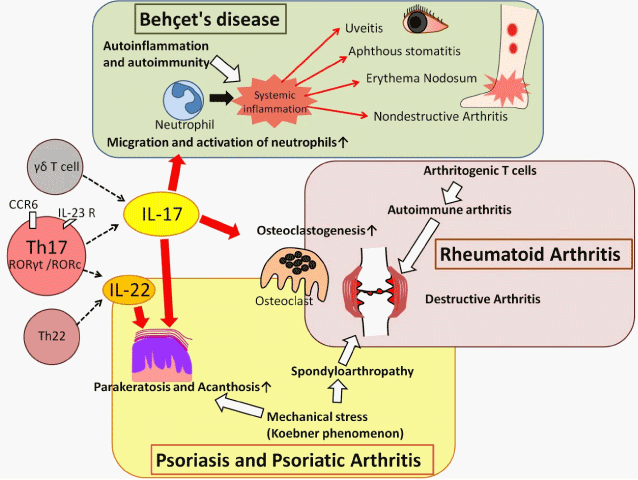 Arthritis can occur in any one of these diseases, but the role of Th17 cells and
Th17-related cytokines in arthritis appears to differ according to disease. In
RA, Th17 cells may play an important role in the initial development of arthritis
and bone destruction caused by the induction of osteoclast formation, causing
subsequent arthritis mutilans, which is characteristic of RA. In psoriasis, Th17
and Th22 cells promote the cutaneous pathophysiology of acanthosis and
parakeratosis while inducing osteoclastogenesis in joints and progression
to osteoclastic arthropathy. Meanwhile, in Behcet’s disease, Th17 and IL-23
abnormalities are involved in neutrophil migration and activation and form the
basis of the various pathophysiologies observed in Behcet’s disease, which
exhibits a principally neutrophilic pathophysiology and sometimes appears to
cause the onset of arthritis.
Arthritis can occur in any one of these diseases, but the role of Th17 cells and
Th17-related cytokines in arthritis appears to differ according to disease. In
RA, Th17 cells may play an important role in the initial development of arthritis
and bone destruction caused by the induction of osteoclast formation, causing
subsequent arthritis mutilans, which is characteristic of RA. In psoriasis, Th17
and Th22 cells promote the cutaneous pathophysiology of acanthosis and
parakeratosis while inducing osteoclastogenesis in joints and progression
to osteoclastic arthropathy. Meanwhile, in Behcet’s disease, Th17 and IL-23
abnormalities are involved in neutrophil migration and activation and form the
basis of the various pathophysiologies observed in Behcet’s disease, which
exhibits a principally neutrophilic pathophysiology and sometimes appears to
cause the onset of arthritis. |
 Arthritis can occur in any one of these diseases, but the role of Th17 cells and
Th17-related cytokines in arthritis appears to differ according to disease. In
RA, Th17 cells may play an important role in the initial development of arthritis
and bone destruction caused by the induction of osteoclast formation, causing
subsequent arthritis mutilans, which is characteristic of RA. In psoriasis, Th17
and Th22 cells promote the cutaneous pathophysiology of acanthosis and
parakeratosis while inducing osteoclastogenesis in joints and progression
to osteoclastic arthropathy. Meanwhile, in Behcet’s disease, Th17 and IL-23
abnormalities are involved in neutrophil migration and activation and form the
basis of the various pathophysiologies observed in Behcet’s disease, which
exhibits a principally neutrophilic pathophysiology and sometimes appears to
cause the onset of arthritis.
Arthritis can occur in any one of these diseases, but the role of Th17 cells and
Th17-related cytokines in arthritis appears to differ according to disease. In
RA, Th17 cells may play an important role in the initial development of arthritis
and bone destruction caused by the induction of osteoclast formation, causing
subsequent arthritis mutilans, which is characteristic of RA. In psoriasis, Th17
and Th22 cells promote the cutaneous pathophysiology of acanthosis and
parakeratosis while inducing osteoclastogenesis in joints and progression
to osteoclastic arthropathy. Meanwhile, in Behcet’s disease, Th17 and IL-23
abnormalities are involved in neutrophil migration and activation and form the
basis of the various pathophysiologies observed in Behcet’s disease, which
exhibits a principally neutrophilic pathophysiology and sometimes appears to
cause the onset of arthritis.